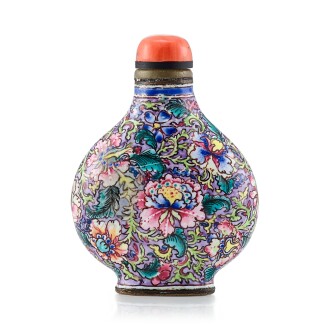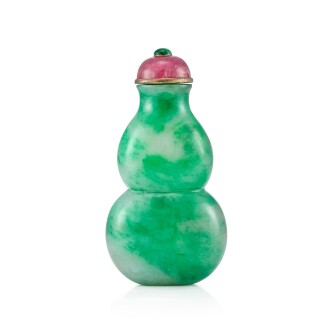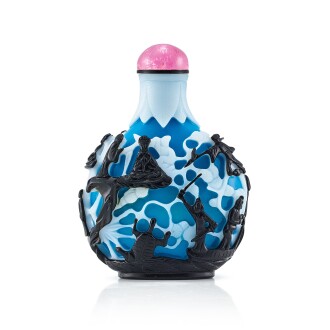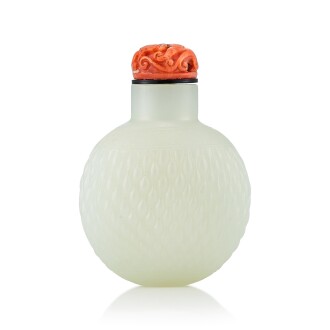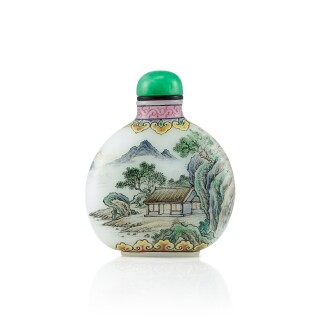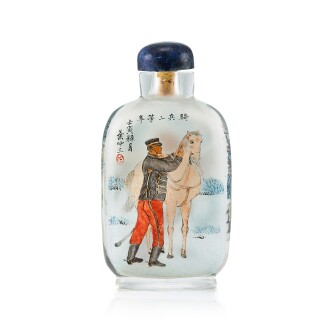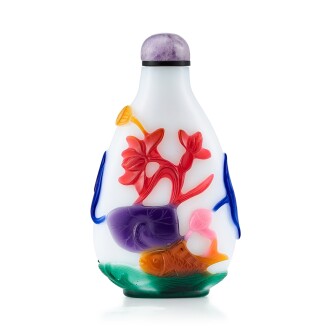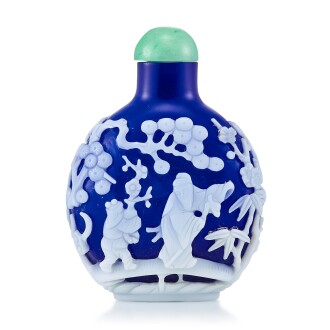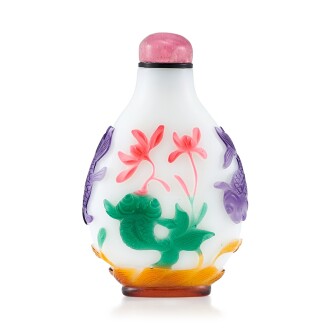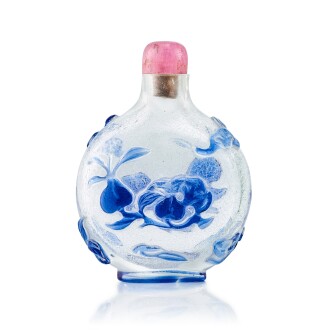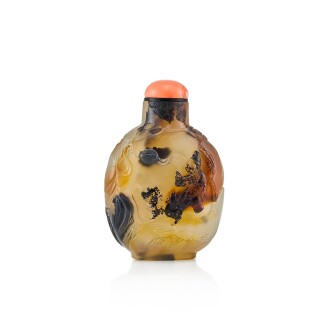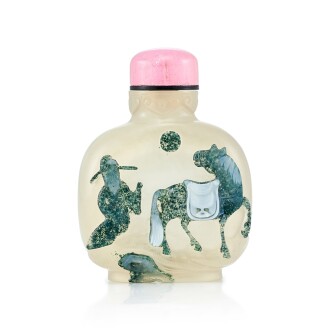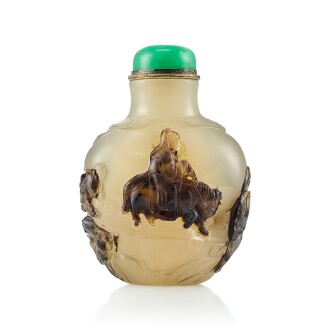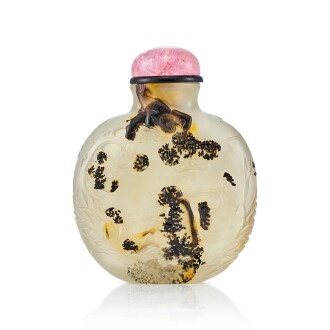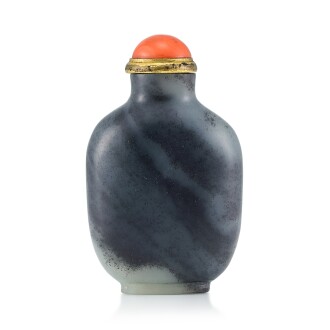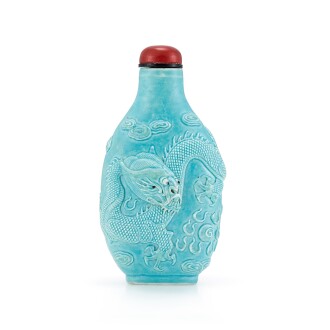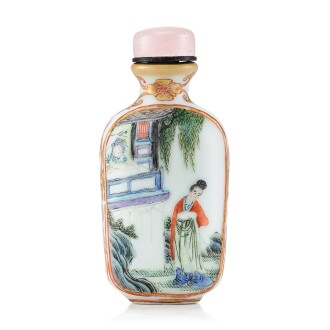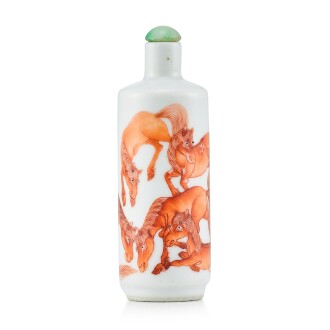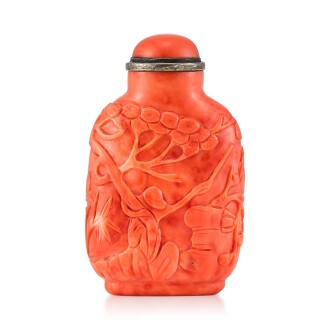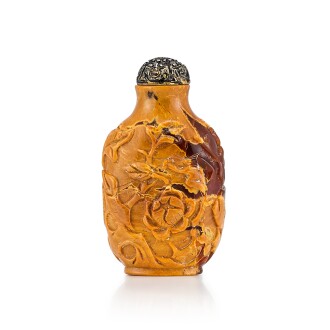S nuff was introduced to China around the late 16th to 17th centuries. A form of pulverized tobacco, it was considered a luxury import from the West. While aristocrats in England and Europe would keep the snuff on their persons in ornamented hinged boxes, airtight bottles were better suited to the comparatively humid climate in China. Since the practice of snuff-taking was very much the province of the fashionable Qing dynasty elite, the pocket-sized bottles would be made of precious materials and decorated in a manner befitting the carrier. Over the centuries the designs would become ever more elaborate, and the snuff bottles would be regarded as objects of high value, exchanged to mark social ties or presented as gifts from the imperial court. Although snuff-taking eventually fell out of fashion, bottles continued to be sought after as collectors’ items.

The portability of these small objects enable enthusiasts to present an entire range of artistic development in the Qing dynasty. The finest collections are more than the sum of its miniature parts – together at a glance telling the story of the wealth and power of the last imperial dynasty of China. Snuff Bottles From A German Private Collection (5–10 February, Hong Kong) presents a fine collection of snuff bottles, assembled by an erudite German collector from the late 1970s to 1990s. Primarily under the guidance of the Hong Kong snuff bottle connoisseur and dealer C.K. Liang, but also from Sotheby’s auctions, the collector was able to acquire the finest examples available on the market. Below are just a selection from the collection to go under the hammer at the upcoming online auction.
HIGHLIGHTS
The quality of the artistry and range of materials used in creation of this rich array of snuff bottles encapsulates the kaleidoscopic diversity of Qing dynasty court art. The highlight of the collection is the group of enamel bottles. A brilliantly enamelled Qianlong period European-subject bottle showcases a motif favoured by the Qianlong Emperor and suggests the influences of European enamelled pieces which were imported as tribute to the Court. A rare Yongzheng reign-marked snuff bottle is delightful with its spontaneous detailing of various flora and fauna, and another rare snuff bottle bearing a Jiaqing reign mark depicts a “Ruby Landscape” exquisitely rendered in puce enamel. The collection is also particularly strong in carved agate and jade bottles, with an additional focus on multi-coloured overlay glass. The jadeite double-gourd snuff bottle represents an auspicious motif symbolising fertility and good fortune, and perhaps capable of absorbing evil vapors of the universe.
ENAMELLED
Antique enamelled snuff bottles show the broad range of Qing dynasty works of art in miniature. The application of the enamel on porcelain, glass or other materials require technical virtuosity and skilled workmanship. The imperial snuff bottles highlighted above offer a glimpse into the aesthetic preferences of different Qing emperors and the high level of skill and artistry during those periods. Another notable example in the collection is the work of the artist Wang Xisan, who was taught the art of enamelling by Ye Bengqi and who used a distinctive technique. Wang did not produce a large number of enamel snuff bottles, and in the collection there is a rare example enamelled with a landscape.
INSIDE PAINTED
These snuff bottles are typically made of crystal or glass, and the interior surface of the bottle served as the canvas for the minuscule painting. Painting from the inside of the snuff bottle would require the highest level of skill, as the artists would apply the decoration using a narrow brush of one or two bristles. These works are a technical wonder. The collection includes rare examples in agate and amber.
OVERLAY GLASS
This collection is notable for the sheer quality of glass bottles. Glass is the most popular type of material owing to its versatility; it has wide range of colour and can imitate the properties of jade, crystal, stone, and amber. Glass snuff bottles feature overlay glass technique, in which layered glass of different colours are carved in low relief.
AGATE
The collection is also particularly strong in carved agate. This type of stone was favoured in snuff bottles, because agate was less prone to shattering than glass in colder climates. Also, part of the challenge and beauty of hardstone carving is the artist’s ability to handle the variegated colours and distinctive bands characteristic of the material. Carved by imaginative and skilled hands, a snuff bottle might incorporate the disposition of the stone into a lively exterior scene.
JADE & JADEITE
For hundreds of years, jade and jadeite have been symbols of supreme status and extreme wealth. Its enigmatic glow has inspired mythologies and a cultural reverence that stretches back centuries. No collection would be complete without a representative selection of jade snuff bottles. Along with the jadeite double-gourd snuff bottle highlighted, the collection also boasts an range of jade or jadeite examples in a variety of colors ranging from green, russet, white, blue, black, and more.
NATURAL STONE
Many snuff bottles feature the natural design of the stone itself without embellishment. A unique example is puddingstone, which is a conglomerate of pebbles cemented together in a matrix over billions of years. The stones are often of contrasting colors and shapes. Highlighted below are two example of snuff bottles, in which the limestone stratum of stone contains fossil material. Many of the other examples have little or no carving and instead showcase the beauty of the natural stone.
PORCELAIN
Porcelain snuff bottles became popular in the 18th century, owing to their versatility; they could be moulded, enamelled, carved, glazed. During the Qianlong period many beautiful snuff bottles were created using new techniques and materials, and the imperial court initiated the production of snuff bottles made of porcelain at Jingdezhen. This continued through the 19th century to the Jiaqing and Daoguang periods, and during this time many of the finest examples of porcelain snuff bottles were made.
OTHER MATERIALS
While snuff bottles are often glass, porcelain, agate and jade, fine examples are made of other precious materials including tourmaline, coral, quartz, crystal, chalcedony, and more.





